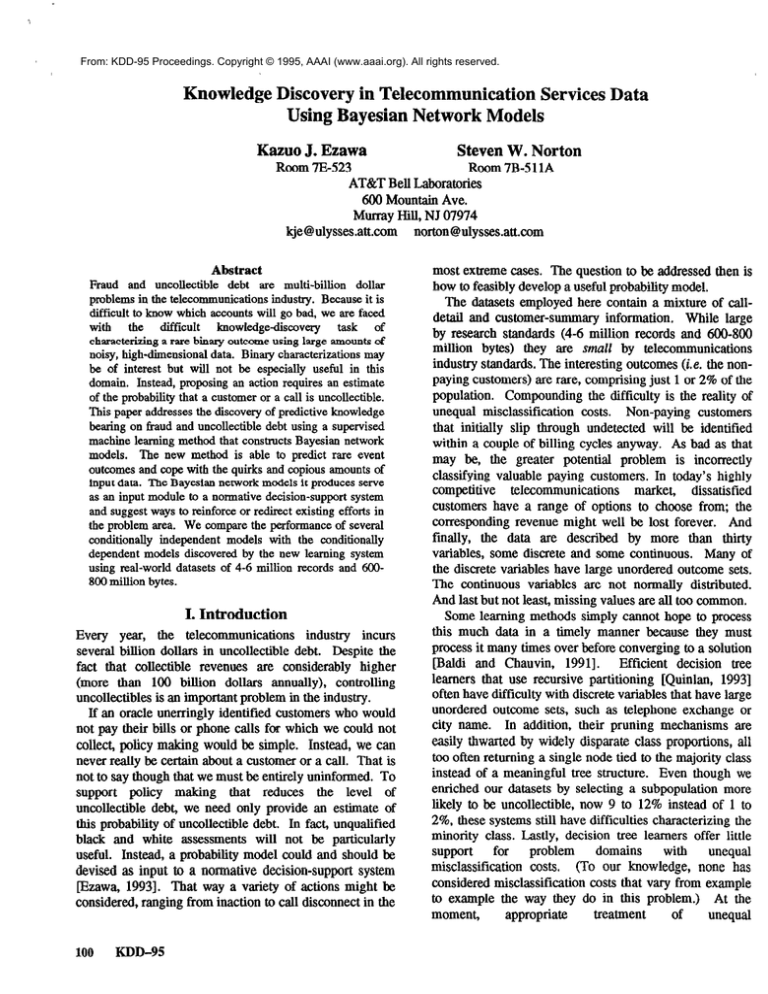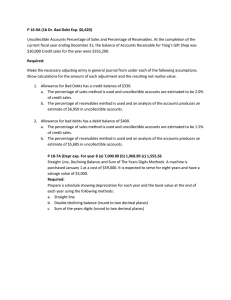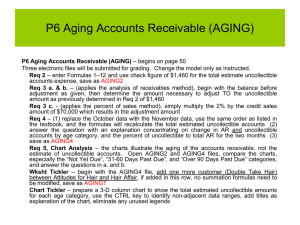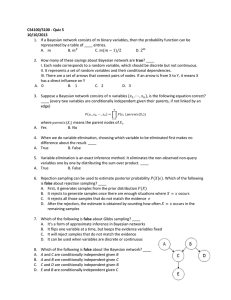
From: KDD-95 Proceedings. Copyright © 1995, AAAI (www.aaai.org). All rights reserved.
Knowledge Discovery in Telecommunication Services Data
Using Bayesian Network Models
Kazuo J. Ezawa
Steven W. Norton
Room 7E-523
Room 7B-5 11A
AT&T Bell Laboratories
600 Mountain Ave.
Murray Hill, NJ 07974
kje@ulysses.att.com norton@ulysses.att.com
Abstract
Fraud and uncollectible debt are multi-billion dollar
problems in the telecommunicationsindustry. Becauseit is
difficult to know which accounts will go bad, we are faced
with
the
difficult
knowledge-discovery
task of
characterizing a rare binary outcome using large amounts of
noisy, high-dimensional data. Binary characterizatioosmay
be of interest but will not be especially useful in this
domain. Instead, proposing an action requires an estimate
of the probability that a customer or a call is uncollectible.
This paper addressesthe discovery of predictive knowledge
bearing on fraud and uncollectible debt using a supervised
machine leamiog method that constructs Bayesiao network
models. The new method is able to predict rare event
outcomes and cope with the quirks and copious amounts of
input data. The Bay&an network models it produces serve
as ao input module to a normative decision-support system
and suggest ways to reinforce or redirect existing efforts in
the problem area. We compare the performance of several
conditionally independent models with the conditionally
dependent models discovered by the new learning system
using real-world datasets of 4-6 million records and 603
800 million bytes.
I. Introduction
Every year, the telecommunications industry incurs
several billion dollars in uncollectible debt. Despite the
fact that collectible revenues are considerably higher
(more than 100 billion dolIars annually), controlling
uncollectibles is an important problem in the industry.
If an oracle unerringly identified customerswho would
not pay their bills or phone calls for which we could not
coiiect, policy making wouid be simpie. instead, we can
never really be certain about a customeror a call. That is
not to say though that we must be entirely uninformed. To
support policy making that reduces the level of
uncollectible debt, we need only provide an estimate of
this probability of uncollectible debt. In fact, unqualified
black and white assessmentswill not be particularly
useful. Instead, a probability model could and should be
-1--.:--a dSc^ z----r
.^ ---.-.-.:-^
2..-:-2-^____^A
__.^ A^__
UtS’lSGU
lIlpU1
W Zl IIUIIIldUVG
Ut3XWIl-SU~pOIl
S)WiUl
Pzawa, 19931. That way a variety of actions might he
considered,ranging from inaction to call disconnectin the
100
KDD-95
most extreme cases. The question to be addressedthen is
how
--
tn
_- feasihlv
-__- -_ , develnn
- -.---=
a uqpfnl
--Cd---
nrnhahilitv
=-‘
-- - ---,
Il?~i.
The datasetsemployed here contain a mixture of calldetail and customer-summaryinformation. While large
by research standards (4-6 million records and 600-800
million bytes) they are small by telecommunications
industry standards.The interesting outcomes(i.e. the nonpaying customers)are rare, comprising just 1 or 2% of the
population. Compounding the difficulty is the reality of
unequal misclassification costs. Non-paying customers
that initially slip through undetected will be identified
within a couple of billing cycles anyway. As bad as that
may be, the greater potential problem is incorrectly
classifying valuable paying customers. In today’s highly
competitive
telecommunications
market,
dissatisfied
customers have a range of options to choose from; the
correspondingrevenue might well be lost forever. And
finally, the data are described by more than thirty
variables, some discrete and some continuous. Many of
the discrete variables have large unordered outcome sets.
The continuous variables are not normally distributed.
And last but not least, missing values are all too common.
Some learning methods simply cannot hope to process
this much data in a timely manner because they must
processit many times over before converging to a soiution
[Baldi and Chauvin, 19911. Efficient decision tree
learners that use recursive partitioning [Quinlan, 19931
often have diificulty with discretevariables that have large
unordered outcome sets, such as telephone exchange or
city name. In addition, their pruning mechanisms are
,..-.A,-*+l....*&^rl
.WluGly
. .. ..a^.-.ulap’
A:--,.-^*..
al......-..^^-A:--”
-1%
uy
““tc tals:,
plupUlwuIIs, ill1
ceuy
ulwiulGu l...
too often returning a single node tied to the majority class
instead of a meaningful tree structure. Even though we
enriched our datasetsby selecting a subpopulation more
likely to be uncollectible, now 9 to 12% instead of 1 to
2%, these systemsstill have difficulties characterizing the
minority class. Lastly, decision tree learners offer little
support for problem domains with
unequal
micclaccifiratinn
-..“I.-“----UYY..
rnck
.sVUY.
CTn
\^.,
nnr
-“-
knnwldoe
-I-.I -v..a-,
nnn~
..“..V
.hat
. ..U
consideredmisclassification costs that vary from example
to example the way they do in this problem.) At the
treatment
of
moment,
appropriate
unequal
misclassification costs is an open research area [Catlett,
1995, Pazzani et al, 19941. All of this is merely to suggest
the kinds of difficulties this data posesto learning systems
in general, whether they are regression systems, nearestneighbor systems,neural networks, etc.
This paper presents the Advanced Pattern Recognition
and Identification (APRI) system, a Bayesian supervised
machine-learning system. Comparisons between APRI
and standard methods such as discriminant analysis and
recursive tree builders can be found elsewhere [Ezawa and
Schuermann, 19951. Instead, the large call-detail datasets
mentioned above will be used here to compare the
conditionally-independent
performance of several
probabilistic models to the performance of conditionallydependentmodels constructed by APRI.
IL The Bayesian Network Approach
Theoretically, the Bayesian CZassQIerCFukunaga,19901
provides optimal classification performance. As a
practical matter, however, its implementation is infeasible.
Recent advances in evidence propagation algorithms
[Shachter 1990, Lauritzen 1988, Pearl 1988, Jensen 1990,
Ezawa 19941 and computer hardware allow us to
approximate the ideal Bayesian classifier using Bayesian
network models [Cheeseman 1988, Herskovits 1990,
Cooper 1992, Buntine 1993, Langley 1994, Provau 19951.
A. The Bayesian Network
The classification problem can be addressed using the
joint probability Pr{x, X} of classesor populations x and
the variables X that describe the data. The classification
of an observation is based on the conditional probability
Pr{n I X}. Assessing this probability directly is often
infeasible due to computational resource limitations. The
conditional probability of the attributes given the classes,
Pr{ X I z}, and the unconditional probability of the classes,
Pr{x}, are often assessed instead by analyzing a
preclassificd training data set. With those probabilities in
hand, Bayes’ rule then yields the desired conditional
probability Pr{ x I X}.
Rewriting Pr{n, X} as a product distribution can shed
light on the underlying probabilistic structure. Figure 1
depicts a model where Pr{q X} is further factored to
attribute level relationships, in particular
Pr{n}xPr{X,In}xPr(X21?c}xPr{X31X2,n}x...
In this standard graphical notation, the conditional
probability of a variable dependsonly on its parents. And
given its parents, a variable is conditionally independent
of the other variables in the network.
B. APRI
The Advanced Pattern Recognition & Identification
(APRl) system developed at AT&T Bell Labs is a
Bayesian network-based supervised machine learning
system that constructs graphical probability models like
those described earlier, using the entropy-basedconcept of
mutual information to perform dependency selection. It
first selects a set of variables and then a set of
dependencies among the selected variables using
heuristically identified mutual information thresholds,
We settled on this approach to reduce the training time
wirn specuu empnasts on repeated reading of the training
dataset. APRI is extremely efficient in this regard. In
fact, it reads the training datasetno more than five times.
APRI constructs graphical probability models using a
four-step process. It takes three inputs: a database of
training cases and two parameters Tt,f and Tf, each
between zero and one. TpI governs variable selection, and
TE governs selection of variable-to-variable links for the
final model.
APRI first scans the database to identify the outcome
sets for each variable. For continuous variables it either
estimates the kernel density or uses information-based
discretization. If the class variable is continuous in the
latter case, APRI fust defines the class outcomes either by
discretization or kernel density estimation.
In the second step, APRI chooses the variables for the
final model. It computes the mutual information between
the class node and each variable, then ranks the variables
accordingly. Without loss of generality, let the indices
from 1 to K reflect the ranking, so that I(n; X1) 2 I@; X2)
2 I@; X3) and so on. APRI selects the smallest number of
variables J out of the entire pool of K variables, such that
iI(n;Xi)
i=l
Figure 1: A Bayesian Network Model
2 Tpf &(rc;Xi)
In other words, the parameter Tpf establishes a mutual
information threshold for choosing relevant variables. A
value of 1 indicates that all the variables should be
incorporated in the model. Lesser values indicate that less
informative variables should be excluded. In the final
graphical model, the class node becomes the parent of
each of the selectedvariables.
Ezawa
101
The third step is akin to the second one, save that it
identifies relationships between variables. In particular, it
computes the conditional mutual information 1(X1;XJ I 7~)
between pairs of the J previously identified variables,
These candidate links are rank ordered.
where i#j.
The highest ranked are then selected until the cumulative
value is just Ttr times the total conditional mutual
information. Diiectionality of these links is based on the
mutual information variable ranking determined in the
second step.
In the fourth and final step, APRI computes Pr{rc} and
Pr{Xj I C(x j} where C(Xj) represents the parents of Xi,
including the class node II.
Reading the dataset from secondary storage is a key
element missing from analyses that assumedata are stored
in fast random-accessmemory [Herskovits 1990, Cooper
1992, Quinlan 1993, Provan 19951. For problem domains
lie ours, the luxury of sufficient random-accessmemory
is unlikely to be available in the near term. APRI is quite
efficient in this regard, reading the databasejust four or
five times: once in the first step for discrete classes or
h.4r.b
LWlvz
A...
I”1
nrm+:.w.c...”
W‘IUII”““~
,.l.,nonn
WaJJFiJ,
+l.arr
UNZLI
,...,.a
“1&G
:n
,.,.A.
111 ciawl
,.F
“I
l l.,.
LUG
*I...,,
UJlcE;
remaining steps.
C. Alternative Methods
A number of other authors have developed algorithms that
search for graphical models by computing joint
probabilities P{B,,D}, where B, is a Bayesian network
structure and D a dataset [Hcrskovits 1990, Cooper 1992,
Heckerman 1994, Provan 19951. This kind of approach
was not taken here, because it is impractical for
applications with massive datasets.
Creation of the data structures that support these
programs could be a problem. In K2 the supporting data
structure is the index tree [Cooper, 1992, pp. 316-3171.
Just two variables with 1,000 or more outcomes (e.g.,
originating and terminating cities) could yield an index
tree with l,OOO,OOO
cells or more. If even a few more
variables with small outcome sets are brought together as
the parents of the same node, constructing and storing the
index tree would be infeasible in typical computing
environments. K2’s search exacerbatesthis difficulty by
considering all possible links at each step, eliminating no
attributes from consideration and making no distinctions
basedon the size of outcome sets.
Even if these programs succeed in creating and storing
their support structures, they face another run-time
problem. If a dataset is too large to hold in memory, they
must read it at least once for each arc in the final
graphical model. For K2, it appears that the dataset
would have to be read O(n(u+l)) times to create a model,
where n is a number of nodes and u the maximum number
of parents per node. With 33 variables and allowing 2
102
KDD-95
parents per node, K2 might need to read the dataset 99
times. If the training data consists of several million
records and perhaps hundreds of millions of bytes of data,
as in the application described here, reading and rereading the data will become the liiiting factor. APRI
reads the dataset just four or five times during model
creation, for any n and u.
Still other authors have investigated the possibility of
very simple probabilistic models mgley
and Sage,
19941. The naive Bayesian classifier estimates probabilities using a fully independent model incorporating all the
given variables. That is:
Pr{n,X} = Pr(Xl7r) x Pr(7c)
= Pr{X,In}xPr{X,I~}x...xPr{X,I~}xPr{n}
Recognizing that certain variables might be irrelevant
or even damaging to the classification, Langley and Sage
also implement a selective Bayesian classifier that
assumes independence but uses a forward search to
develop a limited variable set and uses an error metric as a
stopping criterion. In their experiments, the selective
classifier is never significantly worse than the full
~fi&nf=mdtwt
r-------”
nrrive
..-.-
rlaccifkr
.,-u”“Y-“*(
and
..a...
ic
.”
nftm
“IS”L.
cionifironh~r
“X‘
y.IL’“un.U,
better.
Conditionally independent models are easier to create
and require much less storage than conditionally
dependent models. Of course, if the variables are in fact
conditionally dependent in important ways, the accuracy
of independent Bayesiau classifiers will suffer.
Conditionally dependent models with many interrelated
attributes tend to require more time to create and more
space to store. And of course, additional dependencies
require additional data if the learned model is to be robust.
III. Predicting
Uncollectible
Debt
Four different models are compared in this section. The
dependent models were constructed with APRI, using a
95% cumulative entropy threshold for attribute selection
and a 25% or 45% cumulative entropy threshold for
dependency selection <Tpf and TE respectively). A fully
independent model was also constructed (a naive Bayesian
classifier), as was an independent model limited to the
attributes selected by APRI (analogous to the selective
Bayesian classifier). Because the probability models do
not themselves output a binary classification, an
uncollectible probability threshold is needed to perform
classification. In one set of experiments the uncollectible
probability threshold is 50%. a standard value. It was set
at a more conservative 70% level in a separate
experiment.
The training dataset consists of 4,014,721 records
described by 33 attributes. The size of the dataset is 585
million bytes. The attributes are a mixture of call-detail
information and customer-summary information. The
baseline probability of a call going bad is 9.90%. Training
the conditionally dependentmodel with APRI took about 4
hours on a SUN Spare 20 workstation.
For a practical application, we need to train the model
on data from a particular period and test it on data from a
subsequent period.
This means that out-of-sample
prediction is not with a typical hold-out sample of the
same period but a full set from a subsequent period.
Testing models this way is more demanding but also more
realistic. The testing dataset used here is indeed from a
later period. It contains 5,351,834 records (773 million
bytes) and has an 11.88% unconditional probability of a
call going bad.
Table 1 shows the results of applying the learned
models to this separate dataset taken from a subsequent
period. The numbers in square brackets indicate the total
number of calls for that cell. Becauseof the nature of the
marketplace, incorrectly classified collectible calls must be
minimized at the same time that the number of correctly
classified uncollectible calls is maximized. This suggests
examining the volume ratio in the fourth column, a
quantity that should ideally be minimized. One further
point is worth noting. Because of the nature of the
business, learned classitlers will never have an impact
operationally unless they correctly classify a high enough
percentage of uncollectible calls; otherwise it would be
better to do nothing. Some classifiers with appealing
volume ratios would not meet this requirement.
Table 1: Out-of-Sample
APRI’s dependent models do a good job at out-ofsample prediction. At the 50% prediction level, ie. when
classifying a call as uncollectible requires the predicted
probability to be more than 50%, the model identifies
about 30% of all uncollectible calls and they missclassify
about 6-7% of collectible calls. If we raise the predicted
probability threshold to a more conservative 70%, the ratio
of false positives to true positives improves even more (VP
Column). Being more conservative means that we let a
few bad calls slip through, but gain by falsely identifying
as uncollectible far fewer calls that are in fact collectible.
Neither of the independent models does as well. At any
rate, this table suggeststhat a more conservative threshold
may indeed be appropriate for our application.
Accuracy and False Positive Comnarison (%)
0.1
0.2
0.3
0.4
0.5
0.6
0.7
0.8
I JncollectibleProbabilitv Threshold
Evaluation
ICC
VR
Model Type
ecu
14.01 %
35.06 %
Full Ind.
2.97 : 1
W.WW
[222,874]
( 2 50% *)
7.95 %
22.94 %
Full Ind.
2.57 : 1
[374,969]
[ 145.7991
( 2 70%)
4.32 %
14.73 %
Limited Ind.
[203,601]
P3,6001 2.18: 1
( 2 50%)
1.48 %
5.92 %
Limited Ind.
1.85 : 1
[69,752]
[37,635]
( 2 70%)
6.87%
APRIff25
29.53 %
1.7:1
[323,851]
[ 187,678]
( 2 50%)
2.92 %
17.56 %
APRLff25
[ 137,943]
1.21
( 2 70%)
[11Mw
6.57%
APRIff45
31.86 %
1.5:l
( 2 50%)
[202,500-l
[309,7841
2.85 %
APPIff45
21.10%
T,‘
)” ‘)c\c,
r,‘
)* ,‘),I
I> 7(jqo
L13-+,JUJJ
L13+,1JlJ
1.6:1
CC: Incorrect Classification of Collectible Calls
CCU: Correct Classification of Uncollectible Calls
VR: Volume Patio -- ICC vs. CCU
*: Uncollectible-Call Probability Threshold
0.1 0.2 0.3 0.4 0.5 0.6 0.7 0.8
Uncollectible Probability Threshold
21
Figure 2: Accuracy & Call Volume vs. the Uncollectible
Probability Threshold
E;,-mn..t*
1-l~“~~
,
A
.w.,-,.,:,-l~n
p”vAum
m,x..,a
Ul”lG
,I,%+.-.:1
UIa&ul
“LA..,
mJu”L
I.,....
“VW
. ..l...I-.-r
wrmqpg
rl.a
LUG
uncollectible probability threshold in the range of 10% to
90% affects the proportion of correctly classified calls
(collectible & uncollectible), correctly classified
uncollectible calls, and falsely classified collectible calls.
(It was generated using APRI with a 45% field-to-field
Ezawa
103
The higher the
cumulative entropy threshold.)
uncollectible probability threshold, the more conservative
we are about classification. Fewer good calls are falsely
classified, but at the expenseof correctly identifyiig fewer
bad calls.
If one were to focus only on the top half of Figure 2
(Accuracy and False Positive Comparison), one might
accept a lower, more aggressive uncollectible probability
threshold since throughout the graph, the percentage of
correctly classified uncollectible calls (the true positives)
is larger than the percentage of incorrectly classified
collectible calls (here, the false positives). However,
becauseof the disparity in class proportions, looking at the
classification percentagesis insufficient. The better thing
to do is to examine call volumes as the predicted
probability threshold increases.
The bottom half of Figure 2 also shows how the
corresponding call volumes change in responseto changes
in the uncollectible probability threshold. (The vertical
axis is in a log scale.) This Figure shows that a more
conservative approach is indeed warranted. Only at a
threshold of around 70% does the volume of true positives
exceed the volume of false positives.
IV. Discussion and Summary
This paper has presented a method for learning Bayesian
network models from extremely large datasets. In such
cases, the processing bottleneck is likely to be repeatedly
reading the training dataset from secondary storage.
APRI reads the dataset a constant number of times, not a
number of times linear in the size of the final network. It
does this by thresholding mutual information to select
attributes and dependencies. While this certainly is a
coarse heuristic, there is reason to believe it’s on the right
track. In particular, when APFU’s heuristic was used to
select the variables in the liited independent model, outof-sample performance improved over the full
independent model in every instance, as measured by the
volume ratio.
Overfitting of the learned model to the training data is a
potential problem for all inductive learners. In Bayesian
network models this problem can manifest itself in
probabilities 0 and 1. In APRI the avoidance of
probability 1 in the classification process provides
protection against over-fitting. This feature allows us to
separatethe impact of model complexity from overfitting.
n-2- L;litSSlllGilLlUII
..I^^“:c--r:^^ Al-N
* nnT Sllll~ly
^:--L. ^I-:xl
^Sl ..^..z^L,^
.Wlllc;U
..l..,.l.
UUllll~
SlUJ+
VilllilUlC
causes a classification probability to be one, just as if it
was a missing value. Note that the effect of this “pruning”
step is not explicitly observable on the network itself, but
is implicit in the evaluation of probabilities.
One of the interesting features of predicting
uncollectible debt is the requirement of genuine out-of104
KDD-95
sample testing datasets from separate time periods. Such
testing is essential because of the inevitable lag between
model creation and model deployment. Of course, there is
the risk that fraud or uncollectible patterns will change in
the interim. Seasonal variations could even interfere.
Given enough data, these effects might be modeled. In
addition, active network policies could also change
observed patterns of activity, although there is probably
less hope of modeling the effects of untried policies.
Despite these potential pitfalls, subsequent-periodout-ofsample prediction will remain the real litmus test for this
application.
Lastly, it has become popular in the recent literature to
invoke a gold standard network in the testing and
evaluation of learning methods [Chickering, 19951. At
this stage of our research a gold standard is unavailable
and probably inappropriate, because an inevitable sideeffect of active policies is a change in the patterns of
activity related to uncollectible debt. The reason is that
the fraud and uncollectible debt problem environment is
not static, but dynamic. Whether policies are influenced
by APRI or not, today’s policies directly impact
tomorrow’s uncollectible environment. The better the
uncollectible debt model, the faster its obsolescence.
Success in detecting and treating the uncollectible
accounts or calls, in part, changes the character of future
uncollectible accounts and calls.
The uncollectible
problem simply evolves into a different shape and adjusts
to the new environment. We will not find a gold standard
Bayesian network structure; it changes from moment to
moment. Instead, we choose to emphasize the ability to
create good models in reasonable amounts of time using
very large datasets.
We have demonstrated the performance of APM, a
Bayesian network learning system, on a problem with a
rare binary outcome, mixed data types, and extremely
large datasets. The need for a probabilistic assessment
and the abundance of data limit the set of learning
algorithms we can consider. When compared to several
conditionally independent probability models, the
conditionally dependent models created by APRl do quite
well.
Acknowledgments
We are grateful to Til Schuermann and to the referees
for their careful readings and constructive comments.
References
Baldi, P., and Chauvin, Y., 1991, “Temporal Evolution of
Generalization During Learning in Linear Networks,”
Neural Computation, 3, pp. 589403.
Buntine, W.L. and Smyth, P., 1993, “Learning from Data:
A Probabiliitic Framework,” Tutorial Program, Ninth
Conference on Uncertainty in Artificial Intelligence.
Catlett, J., 1995, “Tailoring Rulesets to Misclassification
Costs”, Preliminary Papers of the Fifth International
Workshop on Artificial Intelligence and Statistics.
Cheeseman, P., Kelly, J., Self, M., Stutz., J., Taylor, W.,
and Freeman, D., 1988, “AUTGCLASS: A Bayesian
Classification System,” Proceedings of the Fi@h
International Conference on Machine Learning pp. 54-64,
Morgan Kaufmann.
Chickering, D.M., Geiger, D., and Heckerman, D., 1995,
“Learning Bayesian Networks: Search Methods and
Experimental Results”, Preliminary Papers of the Fifth
International Workshop on Artificial Intelligence and
statistics.
Cooper, G.F. and Herskovits, E., 1992, “A Bayesian
Method for the Induction of Probabilistic Networks from
Data”, Machine Learning, 9, pp. 309-347.
Ezawa, K.J., 1993, “‘A Normative Decision Support
System”, Third International Conference on Artificial
Intelligence in Economics and Management.
Ezawa, K.J., 1994, “Value of Evidence on Influence
Diagrams”, Proceedings of the Tenth Conference on
Uncertainty in Artificial Intelligence, pp. 212-220,
Morgan Kaufmann.
Langley, P. and Sage, S., 1994, “Induction of Selective
Bayesian Classifiers,” Proceedings of the Tenth
Conference on Uncertainty in Artificial Intelligence, pp.
399-406, Morgan Kaufmann.
Lauritzen, S.L., and Spiegelhalter, D.J., 1988, “Local
Computations with Probabilities on Graphical Structures
and their Application to Expert Systems,”.I. R. Statistics
Society, B, 50, No. 2, pp. 157-224.
Pazzani, M., C. Merz, P. Murphy, K. ali, T. Hume and C.
Brunk, 1994, “‘Reducing Misclassification Costs”, in
Proceedings of the International Conference on Machine
Learning, pp. 217-225, Morgan Kaulinann
Pearl, J., 1988, Probabilistic Reasoning in Intelligent
Systems,Morgan Kautinamr.
Provan, G.M., and Singh, M., 1995, “Learning Bayesian
Networks Using Feature Selection,” Preliiinary Papers of
International Workshop on Artificial Intelligence and
Statistics, pp. 450 - 456.
Quinlan, J. R., 1993, C4.5: Programs for Machine
Learning, Morgan Kaufmann.
Shachter, R. D., 1990, “Evidence Absorption and
Propagation through Evidence Reversals”, Uncertainty in
Artificial Intelligence, Vol. 5, pp. 173-190, NorthHolland.
Schuermann, T.,
1995,
Ezawa,
K.J.,
and
“Fraud/Uncollectible Debt Detection Using a Bayesian
Network Based Learning System: A Rare Binary Outcome
with Mixed Data Structures,” forthcoming in the Eleventh
Conference on Uncertainty in Artificial Intelligence.
Fukunaga, K., 1990, Zntroduction to Statistical Pattern
Recognition, Academic Press.
Heckerman, D.E., Geiger, D., and Chickering D.M., 1994,
“Learning Bayesian Networks: The Combination of
Knowledge and Statistical Data,” Proceedings of the
Tenth Conference on Uncertainty in Artificial
Intelligence, Morgan Kaufmann, pp. 293- 301.
Herskovits, E.H., and Cooper, G.F., 1990, “Kutato: An
entropy-driven system for the construction of probabilistic
expert systems from databases”, Proceedings of the
Conference on Uncertainty in Arti$icial Intelligence, pp.
54 - 62.
Jensen,V., Olesen K. G., and Anderson S. K., 1990, “An
Algebra of Bayesian Universes for Knowledge-Based
Systems,”Network-s,20, pp. 637-659.
Ezawa
105






